The boardroom presentation was flawless. The AI model predicted customer churn with 94% accuracy, identified fraud patterns with precision, and promised to save millions annually.
Six months later, the same model sits disabled in production, its predictions so wildly inaccurate that the customer service team stopped trusting its recommendations.
The company joins the 80% of organizations whose AI projects fail to deliver their promised value, not because the science was wrong, but because the foundation was missing.
This failure epidemic has a name in the industry: the production gap. While data scientists celebrate laboratory successes, businesses struggle with the reality that only less than 35% of AI projects make it into production, and even fewer survive their first year of real-world deployment.
The Data Pipeline is Not an Excel Sheet
AI models perform well in controlled environments where data arrives clean, structured, and predictable.
Production environments offer no such luxury. The gap between laboratory conditions and operational reality represents the first major hurdle that derails most AI initiatives before they begin delivering value.
Consider the typical development process: a data scientist receives a carefully curated dataset, often in CSV format, with missing values already handled and outliers removed.
They build models that perform beautifully on this pristine data. When deployment time arrives, the model confronts live data streams, unstructured inputs, and real-time processing demands that bear little resemblance to the training environment.
This mismatch creates immediate AI model production challenges that most organizations underestimate.
Live data arrives from multiple sources simultaneously, contains formatting inconsistencies, includes unexpected null values, and changes structure without warning.
Without proper data engineering for AI success, even the best models become brittle systems that break under operational stress.
The solution requires building an AI data pipeline infrastructure that can handle the volume, velocity, and variety of production data.
This means creating automated systems that clean, transform, and validate data continuously, ensuring models receive the consistent inputs they were designed to process.
Data engineering bridges the gap between laboratory perfection and operational reality.
Data Drift and Unmonitored Model Decay
The most insidious cause of AI failure occurs gradually and invisibly. Models that initially perform well begin degrading over time as the characteristics of live data drift away from the patterns learned during training.
Without continuous monitoring, this decay remains undetected until predictions become obviously unreliable.
Data drift manifests in countless ways. Customer behavior changes with market conditions, transaction patterns shift during economic uncertainty, and user demographics change as businesses grow.
The model continues making predictions based on outdated patterns, slowly becoming less accurate until its recommendations become counterproductive.
This silent degradation explains why many AI projects appear successful initially but fail to deliver sustained value.
Organizations celebrate early wins while their models quietly become less effective, eventually reaching the point where human judgment consistently outperforms algorithmic recommendations.
By then, stakeholder confidence has eroded, and the entire AI initiative faces cancellation.
MLOps and data engineering practices prevent this decay through automated monitoring systems that track data quality metrics, detect statistical changes in input distributions, and flag when model performance begins declining.
These systems can trigger alerts for manual review or automatically initiate model retraining processes, ensuring AI systems remain accurate and valuable over time.
Wasting Data Scientists on Manual Data “Janitor” Work
Organizations without a proper data engineering infrastructure force their most expensive talent to perform the most basic tasks.
Data scientists, hired for their expertise in machine learning and statistical analysis, spend the majority of their time on data preparation activities that could be automated through proper engineering practices.
Industry research consistently shows that data scientists spend disproportionate time on data cleaning, reformatting, and manual integration tasks rather than the model development work they were hired to perform.
This misallocation of talent creates enormous hidden costs that extend project timelines and reduce the return on AI investments.
The financial impact compounds when considering opportunity costs. Every hour a data scientist spends manually cleaning data is an hour not spent developing innovative solutions, optimizing model performance, or exploring new applications.
Organizations essentially pay premium salaries for routine data processing work that engineering systems could handle automatically.
Data quality for machine learning becomes a strategic business issue when proper infrastructure eliminates these inefficiencies.
Automated data pipelines, quality validation systems, and self-service analytics platforms free data scientists to focus on their core competencies.
This can improve project velocity and increase the likelihood of successful production deployment.
From Reactive Firefighting to Proactive, Scalable Systems
Teams constantly respond to urgent issues: models perform poorly, data pipelines break unexpectedly, and new data sources require manual integration efforts that disrupt ongoing projects.
This method creates organizational chaos that extends far beyond technical problems.
Business stakeholders lose confidence in AI initiatives when they consistently miss deadlines or deliver unreliable results.
Technical teams become demoralized when their carefully developed models fail due to infrastructure limitations beyond their control.
Preventing AI Model Failure requires shifting from reactive firefighting to proactive system design.
This means building resilient data architectures that can handle unexpected changes, scale with business growth, and support multiple AI applications simultaneously.
Companies that invest in proper data engineering infrastructure don’t just improve their chances of individual project success.
They build the foundation for sustained AI innovation that can adapt to changing business needs and market conditions.
Services like Optimus AI Labs’ data engineering help organizations build these foundational capabilities, transforming one-off AI experiments into scalable, reliable systems that deliver consistent business value.
The investment in proper data engineering infrastructure pays dividends across every subsequent AI initiative, turning AI from a risky experiment into a predictable business tool.
The 67% failure rate isn’t inevitable. It’s the predictable result of treating AI as a pure technology challenge rather than recognizing it as a data engineering discipline that requires proper infrastructure, monitoring, and operational practices to succeed.




